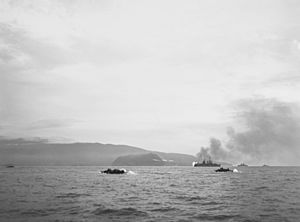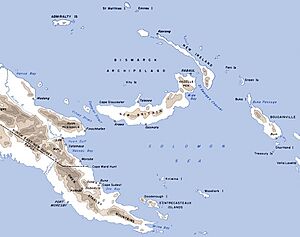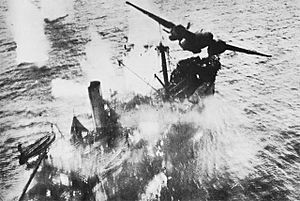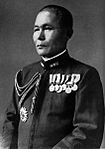New Guinea campaign facts for kids
Quick facts for kids New Guinea Campaign |
|||||||
|---|---|---|---|---|---|---|---|
| Part of the Pacific Theater of World War II | |||||||
 Australian forces attack Japanese positions near Buna |
|||||||
|
|||||||
| Belligerents | |||||||
|
|
|||||||
| Commanders and leaders | |||||||
|
|
||||||
| Strength | |||||||
| 350,000 | |||||||
| Casualties and losses | |||||||
|
42,000 total |
202,100 total killed
|
||||||
The New Guinea campaign was a major part of the Pacific War during World War II. It lasted from January 1942 until August 1945. At first, in early 1942, Japan invaded parts of New Guinea. They took over the Territory of New Guinea and Territory of Papua, and also western New Guinea.
Later, from late 1942 until Japan surrendered, the Allied forces fought back. These forces were mostly from Australia and the United States. They pushed the Japanese out of Papua, then New Guinea, and finally from the Dutch colony.
This campaign was a huge defeat for Japan. Many Japanese soldiers died, mostly from sickness and starvation. Allied ships often cut off Japanese supplies, so many troops couldn't get food or medicine. Some say that 97% of Japanese deaths in this campaign were not from fighting. This campaign was one of the toughest for Allied troops in World War II.
Contents
Key Events of the New Guinea Campaign
Early Battles in 1942
The fighting in New Guinea started when Japan captured Rabaul in January 1942. Rabaul is a city on New Britain island. It had a great harbor and was perfect for building airfields. Japan quickly turned Rabaul into a big air and naval base. The Allies tried to bomb Rabaul to stop them.
The Japanese army in Rabaul was in charge of battles in New Guinea and the Solomon Islands. Their main goal was to capture Port Moresby. This city was the main Allied base in Papua. Taking it would remove a big threat and could even lead to an invasion of Australia.
General Douglas MacArthur, the Allied commander, was determined to hold Port Moresby. He also wanted to take over all of New Guinea. This was part of his plan to eventually recapture the Philippines.
Japanese Landings at Lae and Salamaua
North of Port Moresby, on the coast of Papua, are the towns of Lae and Salamaua. Japanese forces landed there on March 8, 1942, without any opposition. MacArthur wanted to stop them, but he didn't have enough planes or ships. The Japanese bases on New Britain were too strong. Allied planes did bomb Lae and Salamaua, which made the Japanese send more troops there.
Battle of the Coral Sea and Port Moresby
Japan planned to capture Port Moresby by sea in an operation called Operation Mo. Their plan involved setting up seaplane bases and landing troops near Port Moresby. They also had aircraft carriers to protect the landing.
However, in the Battle of the Coral Sea (May 4–8, 1942), the Allies stopped the Japanese landing force. The Allies lost more ships, but they won a big strategic victory. This battle saved Port Moresby from a sea invasion for a while.
After this, Japan planned a new attack on Port Moresby. They decided to attack from two places: Milne Bay and Buna. One attack would be by sea, and the other by land. They would meet at Port Moresby.
The Kokoda Track Campaign
The Japanese easily took Buna on July 21, 1942, because the Allies weren't there. By August 22, Japan had over 11,000 soldiers in Buna. Their goal was to march overland from Buna to Port Moresby. They would follow the Kokoda Track over the Owen Stanley Range mountains. This was meant to cut off Australia from the United States.
By September 17, the Japanese were very close to Port Moresby. But Australian forces held their ground and began to push back on September 26. Many Japanese soldiers died from starvation and sickness during their retreat. This ended the land threat to Port Moresby.
Air Battles Over Port Moresby
Port Moresby was the only port supporting Allied operations in Papua. So, defending it was very important. The Allies used P-39 and P-40 fighter planes for defense. Japanese bombers often flew very high, making them hard to intercept. Many Allied planes were lost in combat or accidents.
Australian and American anti-aircraft gunners were key to protecting Port Moresby. They fired at Japanese planes, forcing them to fly higher. This made their bombing less accurate. Eventually, the Japanese started raiding at night.
Long-range bombers like B-17s couldn't stay safely at Port Moresby. They had to fly from bases in Australia, which was tiring for the crews. Allied planes also attacked Japanese supply points along the Kokoda Track.
Allied Defense of Milne Bay
While MacArthur couldn't stop the Japanese from taking Buna, he could defend Milne Bay. Allied naval forces could easily reach it. In early June, US Army engineers and Australian soldiers landed there. They started building an airfield. By August 22, about 8,500 Australians and 1,300 Americans were at Milne Bay.
The Japanese attacked on August 25. The Battle of Milne Bay lasted until September 7. The Allies won, stopping the Japanese amphibious attack. This battle showed that an attack by sea without air support and with fewer troops than the defenders would fail.
Later, on October 22, Australian troops landed on Goodenough Island. They pushed out the Japanese soldiers who were stranded there. The Allies then turned Goodenough Island into an air base.
Allies Recapture Buna and Gona
The Japanese plan to conquer New Guinea had failed. MacArthur wanted to free the island as a step towards taking back the Philippines. The Allied counterattack began on November 16. The US 32nd Infantry Division was new to jungle fighting and struggled at first. MacArthur even replaced their commander.
The Australian 7th Division and the US 32nd Division then pushed forward. Gona fell to the Australians on December 9, 1942. Buna was taken by the US 32nd on January 2, 1943. Finally, Sanananda, between Buna and Gona, fell to the Australians on January 22.
Operation Lilliput was a supply effort that brought troops and supplies from Milne Bay to Oro Bay. This helped support the fighting in the Buna–Gona area.
Key Events in 1943
Battle of Wau
Wau is a village in Papua with an airfield. This airfield was very important to the Australians. After the Japanese decided to give up on Guadalcanal, they focused more on capturing Port Moresby. Taking the airfield at Wau was a key part of this plan.
Japanese forces, including survivors from Buna-Gona, moved into the Lae-Salamaua area. Australian forces, including the Kanga Force, defended Wau. The Australians won the Battle of Wau (January 29–31, 1943), forcing the Japanese to retreat.
Battle of the Bismarck Sea
Japanese commanders planned to send more troops to Lae for another attack on Wau. They hoped to use bad weather to hide their ships. However, the Allies had strong air forces and were searching for Japanese ships.
Allied bombers, led by Lieutenant General George Kenney, had new tactics. Some planes were fitted with many machine guns to attack ships. They also used "skip bombing," where bombs bounced across the water to hit ships.
On February 28, eight Japanese transport ships and eight destroyers left Rabaul. On March 1, the weather cleared, and Allied planes spotted them. By March 3, the Allies had sunk all eight transport ships and four destroyers. This was a huge disaster for Japan. They never again risked large transport ships in areas where Allied planes could attack. Their plan to attack Wau again was completely stopped.
Operation I-Go Air Raids
After the Bismarck Sea disaster, Admiral Isoroku Yamamoto promised the emperor he would strike back. He sent many planes from aircraft carriers to reinforce the Japanese air fleet at Rabaul. Yamamoto himself moved his headquarters to Rabaul.
This plan, called Operation I-Go, involved massive air strikes. The first strike on April 7 was against Allied ships near Guadalcanal. It was the largest Japanese air attack since Pearl Harbor. Then, Yamamoto focused on New Guinea. Japanese planes attacked Oro Bay on April 11, Port Moresby on April 12, and Milne Bay on April 14.
However, the Japanese greatly overestimated the damage they caused. They thought they sank many ships and planes, but the actual Allied losses were much smaller. This operation showed that Japan was not learning how important air power was. They thought a few big attacks would stop the Allies, but the Allies used constant air strikes.
Allied Plans for Rabaul
The Allies wanted to reduce and capture the huge Japanese bases at Rabaul. They planned two big moves for late June:
- The invasion of the New Georgia Islands (Operation Toenails) in the Solomon Islands.
- Landings in the Trobriand Islands and at Nassau Bay on the Papuan coast.
Eventually, Allied leaders realized that capturing Rabaul would be too costly. Instead, they decided to simply neutralize it and bypass it. This meant they would make Rabaul useless by bombing it and cutting off its supplies, rather than trying to invade it directly. This strategy was agreed upon at the First Quebec Conference in August 1943.
Campaigns from Wau to Salamaua
Even after the Bismarck Sea disaster, Japan kept many resources in New Guinea. The Australians worked to limit Japanese activity there. Any Japanese base would threaten southern New Guinea and northern Australia.
The Allies launched several campaigns to push the Japanese out of these areas:
- The Salamaua-Lae campaign (April 22 – September 16, 1943) involved many battles, including the Landing at Nassau Bay and the Battle of Mount Tambu.
- Operation Postern led to the Landing at Lae and Landing at Nadzab.
- The Bombing of Wewak (August 17–21, 1943) targeted Japanese airfields.
- The Finisterre Range campaign (1943–1944) involved tough fighting in the mountains, like the Battle of Shaggy Ridge.
- The Huon Peninsula campaign (September 22, 1943 – March 1, 1944) included battles like Battle of Finschhafen and Battle of Sattelberg.
- The Bombing of Rabaul (November 1943) continued to weaken the Japanese base.
- The New Britain campaign (December 15, 1943 – August 21, 1945) aimed to secure the island where Rabaul was located.
Later Campaigns (1944–1945)

The Allies continued their push across New Guinea and nearby islands:
- The Admiralty Islands campaign in 1944.
- The Western New Guinea campaign (1944–1945) included several important landings and battles:
- Landing at Aitape
- Landing at Hollandia
- Battle of Wakde
- Battle of Morotai
- Battle of Biak
- Battle of Noemfoor
- Battle of Driniumor River
- Battle of Sansapor
- Aitape–Wewak campaign
These campaigns gradually pushed the Japanese back and secured New Guinea for the Allies. The war ended in August 1945 with Japan's surrender.
See also
- US Naval Base New Guinea
- Naval Base Milne Bay






